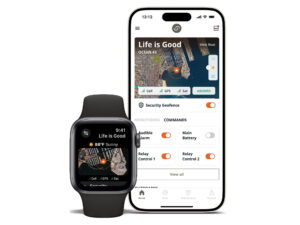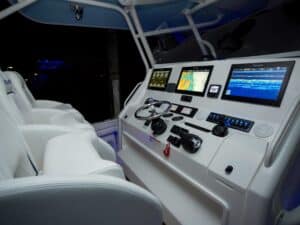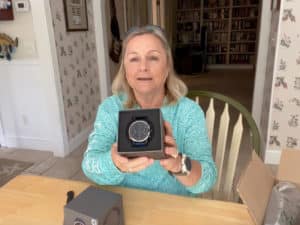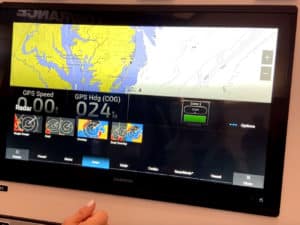
A new breed of autopilot is emerging, and it’s adding even more angling benefits than conventional autopilot systems. It’s all happening thanks to the integration of autopilot systems with electronic throttle and shift controls, steering, GPS, and chart-plotter and heading sensors.
Mercury, MerCruiser, Suzuki, Volvo Penta and Yamaha all offer integrated systems, either factory-rigged or installed aftermarket by qualified dealers.
Advanced features include the ability to fine-tune boatspeed, keep a boat in position, maintain a heading while drifting, stop and hold the position upon arrival, and more. Most—but not all—are integrated with low-speed joystick maneuvering systems.
Digital Driver
Digital throttle and shift, sometimes known as drive-by-wire controls, for marine engines is the enabler of these new features. Many of today’s outboards no longer rely on mechanical cables to connect the helm controls to the engine. Rather, throttle and shift commands are delivered digitally through wires to the engine via computer modules.
One feature of this digital merger is the automatic slowing of the boat’s speed during turns as the boat follows a programmed chart-plotter route to a fishing spot. Known as Route Smoothing, it is available on the FishHunter Drive autopilot system, which integrates Furuno’s NavPilot 300 and Suzuki Marine’s SPC 2.0 engine controls on outboards ranging from 115 to 350 hp. It works with single or multiple Suzuki outboards.
“On turns of more than 30 degrees on a chart-plotter route, the FishHunter Drive will gradually slow boatspeed as it approaches the turn,” says Eric Kunz, senior product manager for Furuno USA. This helps ensure the safety of crew who might otherwise be jostled about during a sudden hard turn at speed.
The FishHunter Drive will perform this function on any kind of route programmed into networked chart plotter, including Garmin’s Auto Guidance function, which automatically calculates the safest route around landmasses, shallows, and other hazards based on chart data and the selected waypoint.

You Have Arrived!
New-age autopilot systems also will deliver your boat to a fishing spot, steering the course to a selected waypoint and slowing or stopping the boat when it arrives.
Yamaha Marine’s Helm Master EX engages the Track Point feature and Waypoint Arrival function so, as the boat cruises toward a programmed waypoint, it will gradually slow the boat at a distance from the waypoint you choose. You can then enter whichever SetPoint function you choose (StayPoint, FishPoint or DriftPoint) at the final waypoint. It works with single or multiple outboards.
“This will give you and your crew an opportunity to get tackle ready and decide how to fish the spot based on the sea conditions,” says David Meeler, manager of new product introductions for Yamaha Marine.
The Furuno/Suzuki FishHunter Drive also can slow the boat as it approaches and stop when it arrives. “The boat will automatically slow down and enable Point Lock to stop and hold the vessel over your favorite fishing spot or destination,” Kunz explains.

Virtual Anchor
Think of a virtual anchor as a form of autopilot, but instead of taking your boat to a destination, it keeps your boat at the destination. Guided by GPS and other sensors, the station-keeping feature generally requires multiple independently steered engines.
The concept was first introduced about eight years ago by Mercury Marine with the Skyhook feature in its Joystick Piloting system. Since then, it’s been refined and augmented with additional features. What’s more, other companies such as Volvo Penta and Yamaha introduced similar functionality soon thereafter.
“Skyhook was a game-changer,” says Rob Hackbarth, director of controls and rigging for Mercury. Today’s Skyhook functions within Joystick Piloting are available for boats with multiple Mercury outboards, MerCruiser sterndrives or Zeus diesel pod drives.
One of the most useful of Skyhook’s features for boating anglers is BowHook, which maintains the boat position—over a wreck, for instance—but allows the boat to take a natural heading. If you need to adjust the heading, you can do so with a twist of the joystick control.
“You can use the original Skyhook feature, which maintains both position and heading, but it can also require a great deal more steering, throttle and shift,” Hackbarth says. BowHook serves as a gentler and quieter means of holding position, and it saves fuel.
Suzuki’s Point Lock and Yamaha’s FishPoint systems are similar. FishPoint offers the additional benefit of choosing whether you want to put the boat’s bow or stern directly over the spot. This helps anglers adjust for different fishing styles, as well as current and wind conditions.
Drift Alignment
For anglers who like to drift-fish, functions such as the Mercury DriftHook, Suzuki/Furuno Sabiki Lock and Yamaha DriftPoint can provide big advantages. All are designed to maintain the boat’s heading (as chosen by the skipper) while allowing for a natural drift with wind and current.
All are great for kite-fishing or working a wreck, and Suzuki touts the hands-free feature as ideally suited for working Sabiki rigs to catch live bait.
Yamaha enhances its DriftPoint feature with DriftPoint Track, which guides the boat to drift along a route programmed into a networked chart plotter. This is really handy when trying to follow a depth contour for species such as flounder.
“When you want to repeat the drift, simply select the waypoint at the top of your drift route and select Track Point,” Meeler explains. “Helm Master EX will use its autopilot to take you back to the beginning of your drift to start over again, notifying crew of Waypoint Arrival before it gets there.”
Editor’s Tip: When buying your next saltwater fishing boat, carefully consider whether to include a joystick system as optional equipment, keeping in mind that these systems are not solely for maneuvering in tight quarters or to ease the task of docking. Because joystick systems integrate digital engine controls, steering, GPS and more, they also enable the advanced autopilot features and angling benefits discussed in this story. -Jim Hendricks, Electronics Editor, Fishing Group








